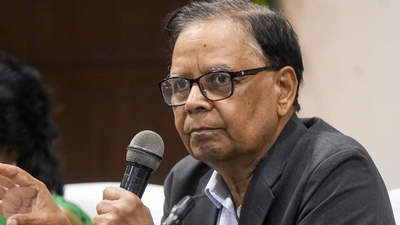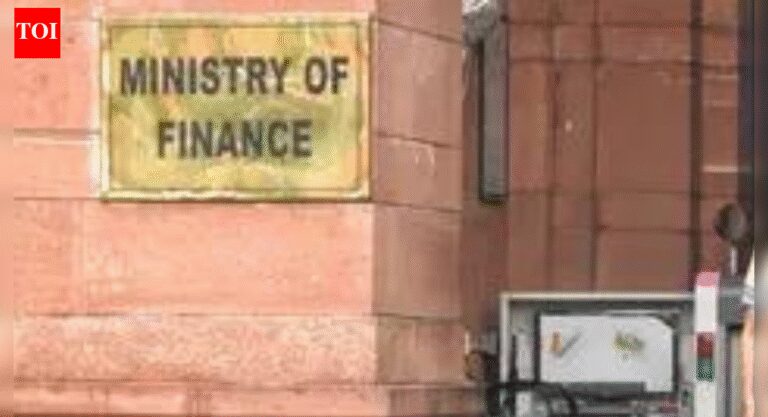
Arvind Panagariya, chairman of the 16th Finance Commission, spoke to TOI after submitting the panel’s report. He speaks on a range of issues from growth prospects for the economy to reforms that need to be pushed. Excerpts:How do you see India’s growth prospects in the short to medium term?Growth prospects in the short to medium term remain excellent. For reasons difficult to understand, forecasts for India consistently underestimate growth.Govt has shown impressive progress in infrastructure build-up, ended the exemption raj in personal income taxation, instituted a two-rate GST, and now implemented the mother of all reforms – the four labour codes. Given these recent developments and the 7.8% growth already achieved in the first quarter, we will easily beat current forecasts and cross the 7% growth mark in 2025-26. In the coming years, we will not only sustain this growth but, with states joining in advancing the reforms, accelerate it.What are the key challenges that need to be addressed?India’s central challenge remains creating high-productivity, well-paid jobs for the masses. The mass of India’s workforce is currently employed in low-productivity jobs, with a majority self-employed. According to the latest 2023-24 Periodic Labor Force Survey (PLFS), 46% of workers are in agriculture, and half of India’s agricultural holdings are smaller than half a hectare. Another 40% of the workers are either self-employed or in establishments with fewer than 10 workers, with access to minimum capital. Only about 10% of the workers are in enterprises with 20 or more workers. Despite three decades since the launch of economic reforms, we have not been able to break out of the Nehru-era industrial edifice, with capital and skilled labour remaining concentrated in a handful of highly capital-intensive sectors, while micro and small establishments populate labour-intensive sectors.Can foreign trade play a major role in India’s growth strategy, like some of the Asian majors, or will it be a domestic market-driven play?This is a choice ours to make. Underlying this choice is also the choice between long-run growth of 6-7% and 9-10%. The latter is what the Asian majors achieved during their high-growth phases (Asian tigers during 1960-90 and China during 1980-2015). With the exports-to-GDP ratio rising from 7% in 1990-91 to 25% at peak in the mid-2010s and imports rising from 10% to above 30% over the same period, trade has been an extremely important contributor to India’s accelerated growth in the post-reform era. Yet it remains true that we have not fully exploited this instrument, which means our growth, though very substantial, has been slower than it could have been.What are the other reforms that govt needs to do?Within our hugely diverse democracy, change is slow. Even though we have made significant progress since 1991, much remains to be done. No doubt, the just implemented four labour codes give the reforms a major shot in the arm.States must take the labour-market reforms further. Urban land markets are highly distorted, with land prices relative to per capita urban incomes among the highest in the world. Custom duties need to be rationalised and reduced. Privatisation of public-sector enterprises in non-strategic sectors needs to be revived. Trade agreements with the US and the EU need to be concluded. I understand the delay in the signing of the former, but what is holding us back on the latter?We also need a major shift in mindset when designing regulations, especially at the RBI and other financial institutions. The regulations should be aimed at the 95% who wish to transact within the law rather than the 5% who want to operate outside it. Overly strict regulation deters not the 5% who intend to violate it under all circumstances, but rather economic activity by those who are committed to following it. Violators are supposed to be deterred through strict enforcement and prosecution.How optimistic are you about the future of India against the backdrop of global uncertainty and geopolitical tensions?My recommendation would be to use this time of global uncertainty to implement the numerous pending domestic economic reforms. In the end, there is no substitute for building a 10 trillion-dollar economy. Heft in the international power game ultimately flows from a nation’s relative economic weight.Arvind Panagariya, chairman of the 16th Finance Commission, spoke to TOI after submitting the panel’s report. He speaks on a range of issues from growth prospects for the economy to reforms that need to be pushed. Excerpts:How do you see India’s growth prospects in the short to medium term?Growth prospects in the short to medium term remain excellent. For reasons difficult to understand, forecasts for India consistently underestimate growth.Govt has shown impressive progress in infrastructure build-up, ended the exemption raj in personal income taxation, instituted a two-rate GST, and now implemented the mother of all reforms – the four labour codes. Given these recent developments and the 7.8% growth already achieved in the first quarter, we will easily beat current forecasts and cross the 7% growth mark in 2025-26. In the coming years, we will not only sustain this growth but, with states joining in advancing the reforms, accelerate it.What are the key challenges that need to be addressed?India’s central challenge remains creating high-productivity, well-paid jobs for the masses. The mass of India’s workforce is currently employed in low-productivity jobs, with a majority self-employed. According to the latest 2023-24 Periodic Labor Force Survey (PLFS), 46% of workers are in agriculture, and half of India’s agricultural holdings are smaller than half a hectare. Another 40% of the workers are either self-employed or in establishments with fewer than 10 workers, with access to minimum capital. Only about 10% of the workers are in enterprises with 20 or more workers. Despite three decades since the launch of economic reforms, we have not been able to break out of the Nehru-era industrial edifice, with capital and skilled labour remaining concentrated in a handful of highly capital-intensive sectors, while micro and small establishments populate labour-intensive sectors.Can foreign trade play a major role in India’s growth strategy, like some of the Asian majors, or will it be a domestic market-driven play?This is a choice ours to make. Underlying this choice is also the choice between long-run growth of 6-7% and 9-10%. The latter is what the Asian majors achieved during their high-growth phases (Asian tigers during 1960-90 and China during 1980-2015). With the exports-to-GDP ratio rising from 7% in 1990-91 to 25% at peak in the mid-2010s and imports rising from 10% to above 30% over the same period, trade has been an extremely important contributor to India’s accelerated growth in the post-reform era. Yet it remains true that we have not fully exploited this instrument, which means our growth, though very substantial, has been slower than it could have been.What are the other reforms that govt needs to do?Within our hugely diverse democracy, change is slow. Even though we have made significant progress since 1991, much remains to be done. No doubt, the just implemented four labour codes give the reforms a major shot in the arm.States must take the labour-market reforms further. Urban land markets are highly distorted, with land prices relative to per capita urban incomes among the highest in the world. Custom duties need to be rationalised and reduced. Privatisation of public-sector enterprises in non-strategic sectors needs to be revived. Trade agreements with the US and the EU need to be concluded. I understand the delay in the signing of the former, but what is holding us back on the latter?We also need a major shift in mindset when designing regulations, especially at the RBI and other financial institutions. The regulations should be aimed at the 95% who wish to transact within the law rather than the 5% who want to operate outside it. Overly strict regulation deters not the 5% who intend to violate it under all circumstances, but rather economic activity by those who are committed to following it. Violators are supposed to be deterred through strict enforcement and prosecution.How optimistic are you about the future of India against the backdrop of global uncertainty and geopolitical tensions?My recommendation would be to use this time of global uncertainty to implement the numerous pending domestic economic reforms. In the end, there is no substitute for building a 10 trillion-dollar economy. Heft in the international power game ultimately flows from a nation’s relative economic weight.







